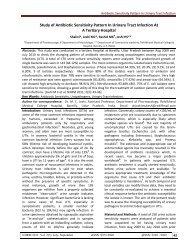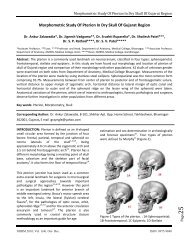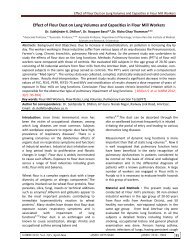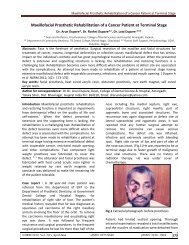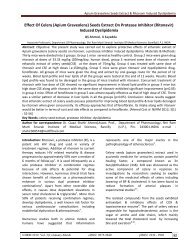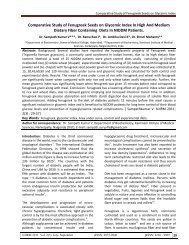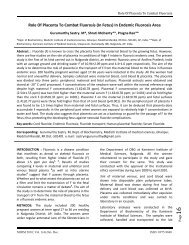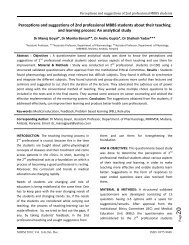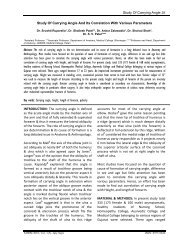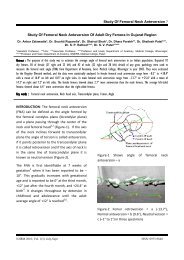Menstrual Pattern of Adolescent School Girls of Bhavnagar (Gujarat)
Menstrual Pattern of Adolescent School Girls of Bhavnagar (Gujarat)
Menstrual Pattern of Adolescent School Girls of Bhavnagar (Gujarat)
Create successful ePaper yourself
Turn your PDF publications into a flip-book with our unique Google optimized e-Paper software.
Page40<br />
<strong>Menstrual</strong> <strong>Pattern</strong> Of <strong>Adolescent</strong> <strong>School</strong> <strong>Girls</strong><br />
<strong>Menstrual</strong> hygiene: Majority <strong>of</strong> girls (87.3%) used<br />
old plain cloth during menstruation and only 10.6<br />
% used commercially available sanitary napkins.<br />
Remaining 13 (1.8%) girls didn’t respond to this<br />
question<br />
Table 5: <strong>Menstrual</strong> Hygiene<br />
Use<br />
Number <strong>of</strong><br />
<strong>Girls</strong><br />
Percenta<br />
ge<br />
(n=725)<br />
Cloth 633 87.3<br />
Sanitary<br />
77 10.6<br />
Pads<br />
Others 2 0.3<br />
Not Stated 13 1.8<br />
Total 725 100.0<br />
DISCUSSION: Our study suggested that 88.1% girls<br />
were informed about menstruation. The main<br />
source <strong>of</strong> information was the mother <strong>of</strong> the girl.<br />
However it was interesting to note that only 1.7%<br />
girls obtained the information from their teachers.<br />
The reason behind this may be that though it is a<br />
girl’s school, about half <strong>of</strong> the teachers are male.<br />
At the same time, even female teachers may feel<br />
embarrassed talking on this topic. The mean age <strong>of</strong><br />
menarche in our study was found to be 13.995<br />
(S.D. 1.8). The results are almost same as by Singh<br />
M.M. et al 2 . In their study, the mean age <strong>of</strong><br />
menarche was 13.6. In another study in rural<br />
Orissa, the mean age <strong>of</strong> menarche was found to be<br />
12.97 (S.D. 0.99) 3 . Although menarche is an<br />
occasion for celebration in south India, particularly<br />
in Tamilian people, the girls are rarely informed<br />
about it there also; very little information is given<br />
to young girls about the physiological processes<br />
involved and hygienic practices to be followed 1 .<br />
The most common menstrual problem was<br />
dysmenorrhea (50.6%), followed by irregular<br />
menses (22.9%). Though the dysmenorrhea was<br />
common, out <strong>of</strong> those 367 who had it, only 22.6%<br />
sought for help either to a doctor or their mother.<br />
Remaining accepted it as their destiny. Other<br />
studies have also found the dysmenorrhea the<br />
most common menstrual disorder 4, 5 . It was<br />
amazing to note that still most <strong>of</strong> the girls (87.3%)<br />
use old plain cloth as absorbent during<br />
menstruation and only 10.6% use commercially<br />
available sanitary napkins. However it was<br />
not clear, whether the reason for this was their<br />
economic status or just their hesitation.<br />
CONCLUSION AND RECOMMENDATION: <strong>Girls</strong><br />
should be informed well in advance about the<br />
menstruation, physiological process involved, its<br />
importance etc. Mothers are primarily responsible<br />
for the transmission <strong>of</strong> such type <strong>of</strong> information.<br />
This will help the girls to take it positively. Hygiene<br />
during menstruation should be maintained, so to<br />
avoid any reproductive tract infection. Teachers’<br />
role for the transmission <strong>of</strong> information.<br />
ACKNOWLEDGEMENTS: We are highly thankful to<br />
principal and teachers <strong>of</strong> the school for the<br />
providing permission and support to conduct the<br />
study. We also acknowledge all the girls who<br />
participated in this study.<br />
REFERENCES:<br />
1. Narayan K.A. et al: “Puberty Rituals,<br />
Reproductive Knowledge and Health <strong>of</strong><br />
<strong>Adolescent</strong> <strong>School</strong>girls in South India.”, Asia<br />
Pacific Population Journal, Vol. 16, No. 2, 224-<br />
236.<br />
2. Singh M.M. et al “Awareness and health<br />
seeking behaviour <strong>of</strong> rural adolescent school<br />
girls on menstrual and reproductive health<br />
problems”, I.J.M.R., 1999. Vol. 53, Issue 10,<br />
439-43.<br />
3. Dutta Himansu Sekhar, “Sexual health status <strong>of</strong><br />
adolescent girls in rural Orissa”,<br />
http://www.orissavha.org/studies/shstudy/20<br />
2001-2.doc<br />
4. Drakshayani Devi K. et al “A study on<br />
menstrual hygiene among rural adolescent<br />
girls”, IJMS, 1994 Vol. 48 Issue 6,139-43<br />
5. Ganguly Mukherjee Gita et al “Knowledge <strong>of</strong><br />
Reproductive Health Issues among the <strong>School</strong><br />
going Teenagers <strong>of</strong> Rural Bengal”, J. Obst.<br />
Gyne. India, Vo. 41, No. 1: Jan/Feb. 2001,115-<br />
118<br />
NJIRM 2011; Vol. 2(1).Jan-March eISSN: 0975-9840 pISSN: 2230 - 9969



